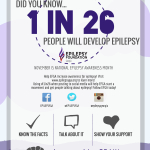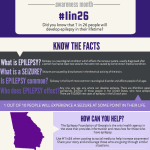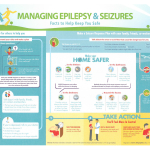During the month of November, take to Facebook, Twitter, a blog, your own website, and Instagram to help increase awareness! Share facts about epilepsy daily, your own story, share photos of your purple and help get the conversation started! Follow EFGA on Facebook, Twitter & Instagram and feel free to share our post on your page!
Don’t forget to use #1in26 when posting to ALL social media! Then check out the Tagboard on our November page to see your and anyone else’s posts using #1in26. Let’s start a movement! IT STARTS WITH YOU!
Check out these great infographics for you to share and help increase awareness! Download the pdf version to share!
1in26 Infographic
EFGA Facts Infographic
Managing Epilepsy Infographic
Here are some key numbers (in Tweet-size bites) to talk about it!
- 65 MILLION: Number of people around the world who have epilepsy.
- OVER 2 MILLION: Number of people in the United States who have epilepsy.
- 1 IN 26 people in the United States will develop epilepsy at some point in their lifetime.
- BETWEEN 4 AND 10 OUT OF 1,000: Number of people on earth who live with active seizures at any one time.
- 150,000: Number of new cases of epilepsy in the United States each year
- ONE-THIRD: Number of people with epilepsy who live with uncontrollable seizures because no available treatment works for them.
- 6 OUT OF 10: Number of people with epilepsy where the cause is unknown.
Let’s wipe out some myths, SHARE THE FACTS!
Myth: Epilepsy can be cured.
Fact: There is no known cure for epilepsy. However, modern treatment methods can achieve full control of seizures in a majority of cases.
Myth: Epilepsy is a lifelong disorder.
Fact: Epilepsy is not necessarily a lifelong disorder. Many persons with epilepsy will not have seizures or require medication all of their lives.
Myth: Persons with epilepsy are “epileptics.”
Fact: Persons with epilepsy are individuals who experience chronic, recurring seizures and prefer being described as a “person with epilepsy.”
Myth: Epilepsy is a psychological condition.
Fact: Epilepsy is a medical condition. Seizures are the result of an excessive and disorderly discharge of electrical energy in the brain.
Myth: You have to be born with epilepsy.
Fact: Epilepsy often first appears in children and young adults, although anyone can develop epilepsy at any time.
Myth: You can’t prevent epilepsy.
Fact: While no specific cause can be pinpointed, in some cases, severe head injuries experienced in falling from a bicycle or sustained in an automobile accident, have been identified.
Myth: You should put an object, such as a spoon, in the mouth of a person having a seizure to keep them from swallowing their tongue.
Fact: Nothing should be placed in the person’s mouth. While it is not physically possible to swallow one’s tongue, if the tongue is relaxed, it could block the breathing passage. Therefore, the person should be turned on his side so the tongue falls away and to the side.
Myth: Epilepsy is rare.
Fact: Approximately 3 million Americans have epilepsy and statistics show that 1 in 26 people will develop Epilepsy in their lifetime.
Myth: Epilepsy is contagious.
Fact: Epilepsy is NOT contagious.
Do you know SEIZURE FIRST AID?
Not sure what to do? Follow this commonsense advice.
DO make the person as comfortable as possible. Loosen neckties, scarves or anything around the neck. Place something flat and soft, such as a towel or jacket, under the head.
DO reassure anyone who is nearby and discourage onlookers from intruding. Remember, if you stay calm, others will too.
DON’T restrain the person or hold them down. Make sure there is nothing hard or sharp nearby that could cause harm.
DON’T stick your finger or any other object in the person’s mouth. It is not true that a person experiencing a seizure can swallow their tongue. Avoid artificial respiration (such as CPR) except n the rare event that the person is not breathing after the seizure has stopped.
DO stay with the person until the seizure ends naturally. Then place the person on his or her left side. Post-seizure vomiting can occur before the person is fully conscious; turn the head so the vomit can drain without being breathed in.
DO be as gentle and supportive as possible as consciousness returns.
DO time the length of the seizure. This could be important information for the person’s doctor to know. Call 911 if it lasts longer than 5 minutes.
DON’T offer water, pills or food until the person is fully conscious.
Download these easy to read PDFs for Seizure First Aid!
First Aid 1 First Aid 2



